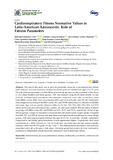Mostrar el registro sencillo del ítem
Cardiorespiratory fitness normative values in Latin-american adolescents: role of fatness parameters
| dc.creator | Ramírez Vélez, Robinson | es_ES |
| dc.creator | García Hermoso, Antonio | es_ES |
| dc.creator | Alonso Martínez, Alicia | es_ES |
| dc.creator | Agostinis-Sobrinho, César | es_ES |
| dc.creator | Correa Bautista, Jorge Enrique | es_ES |
| dc.creator | Triana Reina, Héctor Reynaldo | es_ES |
| dc.creator | Izquierdo Redín, Mikel | es_ES |
| dc.date.accessioned | 2020-05-12T11:15:26Z | |
| dc.date.available | 2020-05-12T11:15:26Z | |
| dc.date.issued | 2019 | |
| dc.identifier.issn | 1661-7827 | |
| dc.identifier.uri | https://hdl.handle.net/2454/36868 | |
| dc.description.abstract | The aim of this study was to provide percentile values for a cardiorespiratory fitness (CRF) field test for Latin-American adolescents (34,461 girls and 38,044 boys) aged 13 to 15 years. The role of fatness parameters on the CRF level across age groups was also examined, with a focus on non-obese (healthy) and obese groups. CRF was assessed using the 20-meter shuttle run test protocol. Anthropometric parameters were measured using body mass index z-score (body mass index (BMI) z-score), BMI, waist circumference (WC), and waist-to-height ratio (WHtR). Participants were categorized according to the BMI z-score, WC, and WHtR international cut-off points as healthy and obese. Age-and sex-specific reference tables for the 3rd, 10th, 25th, 50th, 75th, 90th, and 97th centile scores were calculated using Cole’s lambda, mu, and sigma method. The prevalence of obesity according to the BMI z-score, WC, and WHtR was 9.6%, 11.2%, and 15.0%, respectively. Across all age and sex groups, a negative association was found between relative peak oxygen uptake (VO2 peak) and BMI, WC, and WHtR. In boys and girls there were higher levels of performance across all age groups, with most apparent gains between the ages of 13 and 14 years old. Overall, participants categorized in the healthy group had shown to have significantly higher VO2 peak than their obese counterparts (p < 0.001; Cohen’s d> 1.0). In conclusion, our study provides age-and sex-specific reference values for CRF (VO2 peak, mL·kg−1·min−1 ). The anthropometric parameters were inversely associated with CRF in all ages in both sexes. The obese group had worse CRF than their healthy counterparts independent of anthropometric parameters used to determine obesity. | en |
| dc.description.sponsorship | This study (Colombia sample) is supported by Secretaria de Educación Distrital-SED (ID Convenio N CDP 3381, Project N 893 'Pensar en Educación-Fuprecol project' date 2 October 2014). The Fuprecol project was carried out with the financial support of Instituto Colombiano para el Desarrollo de la Ciencia y la Tecnología 'Francisco José de Caldas' COLCIENCIAS (Contract No. 671-2014 Code 122265743978). Mikel Izquierdo is funded in part by a research grant PI17/01814 of the Ministerio de Economía, Industria y Competitividad de España (ISCIII, FEDER). | en |
| dc.format.extent | 11 p. | |
| dc.format.mimetype | application/pdf | en |
| dc.language.iso | eng | en |
| dc.publisher | MDPI | en |
| dc.relation.ispartof | International Journal of Environmental Research and Public Health, 2019, 16 (20), 3889 | en |
| dc.rights | © 2019 by the authors. Licensee MDPI, Basel, Switzerland. This article is an open access article distributed under the terms and conditions of the Creative Commons Attribution (CC BY) license | en |
| dc.rights.uri | http://creativecommons.org/licenses/by/4.0/ | |
| dc.subject | Aerobic fitness | en |
| dc.subject | Physical performance | en |
| dc.subject | Obesity | en |
| dc.subject | Adolescents | en |
| dc.subject | Prevention | en |
| dc.subject | Cardiovascular risk factors | en |
| dc.title | Cardiorespiratory fitness normative values in Latin-american adolescents: role of fatness parameters | en |
| dc.type | info:eu-repo/semantics/article | en |
| dc.type | Artículo / Artikulua | es |
| dc.contributor.department | Ciencias de la Salud | es_ES |
| dc.contributor.department | Osasun Zientziak | eu |
| dc.rights.accessRights | info:eu-repo/semantics/openAccess | en |
| dc.rights.accessRights | Acceso abierto / Sarbide irekia | es |
| dc.identifier.doi | 10.3390/ijerph16203889 | |
| dc.relation.publisherversion | https://doi.org/10.3390/ijerph16203889 | |
| dc.type.version | info:eu-repo/semantics/publishedVersion | en |
| dc.type.version | Versión publicada / Argitaratu den bertsioa | es |



